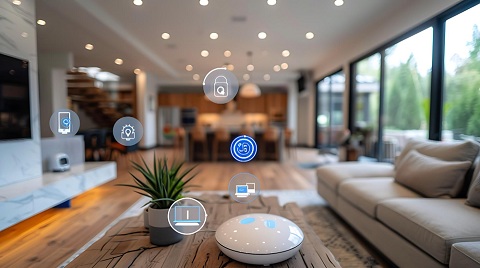Smart home design is rapidly transforming how we live, offering unprecedented levels of convenience, efficiency, and security. Whether you’re building a new home or retrofitting your existing one, understanding the fundamentals of smart home design can help you make informed decisions and create a living space that’s both innovative and functional.
What is Smart Home Design?
Definition and Concept
Smart home design refers to the integration of advanced technologies into your home to automate and control various systems and appliances. This includes everything from lighting and climate control to security and entertainment systems.
Evolution of Smart Home Technology
The concept of smart homes has evolved significantly over the past few decades. Early home automation systems were limited in functionality and accessibility. Today, advancements in technology have made it possible to control virtually every aspect of your home environment through smart devices and applications.
Benefits of Smart Home Design
Convenience
One of the primary benefits of smart home design is the convenience it offers. With a smart home system, you can control your lighting, thermostat, security cameras, and more with just a few taps on your smartphone or through voice commands.
Energy Efficiency
Smart home technologies can significantly reduce your energy consumption. Smart thermostats, for instance, learn your schedule and adjust the temperature accordingly, while smart lighting systems ensure lights are only on when needed.
Enhanced Security
Smart home design enhances your home’s security through features like smart locks, video doorbells, and security cameras. These systems can send real-time alerts to your phone, allowing you to monitor and control your home’s security remotely.
Key Components of a Smart Home
Smart Lighting
Smart lighting systems allow you to control the brightness and color of your lights remotely. They can be scheduled to turn on and off at specific times, helping to save energy and improve security.
Smart Thermostats
Smart thermostats offer precise control over your home’s temperature, learning your preferences over time and adjusting settings to optimize comfort and energy efficiency.
Smart Security Systems
Smart security systems include devices like smart locks, video doorbells, and surveillance cameras. These systems can be integrated to provide comprehensive security coverage, accessible from anywhere.
Smart Appliances
From smart refrigerators to washing machines, smart appliances can be controlled remotely, offering convenience and efficiency in managing household chores.
Smart Kitchen Appliances
Smart kitchen appliances, such as refrigerators, ovens, and dishwashers, offer advanced features like remote monitoring, automatic adjustments, and notifications. These appliances can make meal preparation and kitchen management more efficient.
Smart Laundry Solutions
Smart washers and dryers can be controlled remotely, offering features like cycle customization and maintenance alerts. These appliances help save time and ensure your laundry is done exactly how you prefer.
Smart TVs and Speakers
Smart TVs and speakers offer access to streaming services, voice control, and integration with other smart devices. These systems provide a rich entertainment experience with minimal effort.
Home Theater Systems
Smart home theater systems combine high-quality audio and video with the convenience of smart technology. They can be controlled via apps or voice commands, creating an immersive entertainment experience.
Planning Your Smart Home Design
Assessing Your Needs
Before diving into smart home design, it’s essential to assess your needs. Consider which aspects of your home would benefit most from automation and control, and prioritize those systems.
Budget Considerations
Smart home technologies can range from affordable to high-end luxury systems. Determine your budget early on and choose devices that offer the best value and functionality within your price range.
Choosing the Right Technology
With so many options available, selecting the right technology can be overwhelming. Research different products, read reviews, and consider compatibility with existing systems in your home.
Choose a Smart Home Ecosystem
Selecting a compatible ecosystem is crucial for seamless integration. Popular ecosystems include Google Home, Amazon Alexa, and Apple HomeKit. Choose one that aligns with your existing devices and preferences.
Start Small
If you’re new to smart home technology, consider starting with a few key devices, such as a smart thermostat and smart lighting. This allows you to familiarize yourself with the technology before expanding your system.
Integrate Gradually
Gradually integrate additional smart devices into your home. This approach ensures that you can manage and optimize each device effectively, creating a cohesive and efficient smart home environment.
Installation and Integration
DIY vs Professional Installation
While many smart home devices are designed for easy DIY installation, more complex systems may require professional setup. Consider your technical skills and the complexity of the installation before deciding.
Integrating Different Systems
Integration is key to a seamless smart home experience. Ensure that the devices you choose can communicate with each other and be controlled through a central platform.
Popular Smart Home Systems and Platforms
Amazon Alexa
Amazon Alexa is a popular voice-controlled platform that can integrate with a wide range of smart home devices, offering extensive functionality and ease of use.
Google Home
Google Home offers robust voice control and integration with various smart devices, making it a strong competitor in the smart home market.
Apple HomeKit
Apple HomeKit provides a secure and user-friendly platform for managing smart home devices, particularly for users invested in the Apple ecosystem.
Philips Hue
Philips Hue offers a range of smart lighting solutions that can be controlled remotely and customized to create the perfect lighting ambiance. They are compatible with various smart home ecosystems.
Ring Video Doorbell
The Ring Video Doorbell enhances your home security by allowing you to see and communicate with visitors remotely. It features motion detection, real-time notifications, and video recording capabilities.
Ecobee Smart Thermostat
Ecobee’s smart thermostat offers advanced features like room-specific temperature control, occupancy sensing, and integration with various smart home ecosystems. It helps optimize comfort and energy efficiency.
Future Trends in Smart Home Design
Artificial Intelligence
AI is set to revolutionize smart home design by enabling systems to learn from user behavior and make intelligent decisions to enhance convenience and efficiency.
Enhanced Interconnectivity
Future smart homes will feature even greater interconnectivity, allowing for more seamless communication between devices and systems.
Sustainable Technologies
Sustainability is becoming increasingly important in smart home design, with new technologies focusing on reducing energy consumption and minimizing environmental impact.
Health and Wellness Integration
Future smart homes will prioritize health and wellness, incorporating devices that monitor air quality, provide fitness tracking, and offer advanced healthcare solutions.
Voice and Gesture Control
Voice and gesture control will become more sophisticated, offering a more natural and intuitive way to interact with smart home devices. This enhances accessibility and convenience for all users.
Why Is a Smart Home Important?
In today’s rapidly advancing technological landscape, smart homes are becoming increasingly essential. Here’s why a smart home is important:
Convenience and Comfort
Smart home technology provides unparalleled convenience. With the ability to control lighting, heating, security, and entertainment systems through your smartphone or voice commands, daily tasks become much simpler and more enjoyable. Imagine adjusting your home’s temperature on your way back from work or dimming the lights without leaving the couch.
Enhanced Security
Smart homes significantly improve security. Smart locks, surveillance cameras, motion sensors, and alarm systems can be monitored and controlled remotely, offering real-time alerts and peace of mind. You can check who is at your front door, lock doors remotely, and receive instant notifications of any suspicious activity.
Energy Efficiency
One of the standout benefits of smart home technology is energy efficiency. Smart thermostats, lighting systems, and appliances are designed to optimize energy use. They can be programmed to operate only when needed, reducing energy waste and lowering utility bills. For instance, a smart thermostat can learn your schedule and adjust heating or cooling accordingly.
Cost Savings
While there is an initial investment in smart home technology, the long-term savings can be substantial. Energy-efficient devices and systems help reduce electricity and heating costs. Additionally, smart home technology can extend the lifespan of your appliances by ensuring they are used optimally and maintained properly.
Accessibility
Smart homes enhance accessibility, especially for individuals with disabilities or the elderly. Voice-activated assistants and automated systems make it easier to perform daily tasks, from turning on lights to locking doors. This can greatly improve the quality of life and independence for those with mobility challenges.
Customization and Control
Smart home systems offer high levels of customization. You can create personalized settings and routines that align with your lifestyle. For example, you can set your home to wake you up with a specific light setting, adjust the thermostat, and play your favorite music. This level of control allows you to create a living environment that perfectly suits your needs.
Improved Health and Well-being
Smart home devices can also contribute to better health and well-being. Air quality monitors, for instance, can detect pollutants and allergens, prompting you to take action to improve indoor air quality. Smart lighting can mimic natural light patterns, promoting better sleep cycles and overall well-being.
Future-Proofing Your Home
Investing in smart home technology is a step towards future-proofing your home. As technology continues to evolve, smart homes will likely become the standard. By adopting smart home systems now, you’re preparing your home for future advancements and increasing its market value.
Remote Monitoring and Management
With smart home technology, you can monitor and manage your home from anywhere in the world. This is particularly useful for frequent travelers or homeowners with multiple properties. You can check security cameras, control lighting, and manage appliances remotely, ensuring your home is always under control.
Eco-Friendly Living
Smart homes support eco-friendly living. By optimizing energy use and integrating with renewable energy sources, such as solar panels, smart homes can significantly reduce your carbon footprint. Smart irrigation systems can also help conserve water by adjusting watering schedules based on weather conditions.
Advantages and Disadvantages of Smart Homes
Pros/Advantages
Convenience
Smart homes offer unparalleled convenience. You can control lighting, temperature, security systems, and appliances with your smartphone or voice commands. This means you can adjust your home’s environment without leaving your seat, and even manage your home while you’re away.
Energy Efficiency
Smart home devices can help reduce energy consumption. For instance, smart thermostats learn your schedule and adjust heating and cooling accordingly, while smart lighting systems ensure lights are only on when needed. This can lead to significant savings on energy bills.
Enhanced Security
Smart home security systems, including smart locks, video doorbells, and surveillance cameras, provide enhanced security features. These systems can send real-time alerts to your phone, allowing you to monitor and control your home’s security remotely, offering peace of mind.
Increased Home Value
Investing in smart home technology can increase your home’s value. Many homebuyers are looking for modern, tech-savvy homes, and having a smart home system in place can make your property more attractive to potential buyers.
Customization
Smart home systems are highly customizable. You can set up routines and schedules that fit your lifestyle, such as having your lights turn on when you get home or your coffee maker start brewing before you wake up.
Cons/Disadvantages
Cost
The initial cost of smart home devices and systems can be high. While they can save money in the long run, the upfront investment might be a barrier for some homeowners. Additionally, high-end smart devices and professional installation can add to the overall cost.
Compatibility Issues
Not all smart home devices are compatible with each other. Different brands and technologies may not work seamlessly together, which can complicate the integration of a comprehensive smart home system.
Privacy and Security Concerns
Smart home devices collect and transmit data, raising privacy and security concerns. If not properly secured, these devices can be vulnerable to hacking, potentially exposing personal information and compromising home security.
Dependence on Internet Connectivity
Smart home systems rely heavily on internet connectivity. If your internet goes down, you may lose control of your smart devices, leading to inconvenience and potential security risks.
Complexity
Setting up and managing a smart home system can be complex, especially for those who are not tech-savvy. Troubleshooting issues and keeping up with software updates can also be challenging for some users.
FAQs about Smart Home Design
Essential components include smart lighting, smart thermostats, smart security systems, and smart appliances.
Smart home devices like thermostats and lighting systems optimize energy use by learning your habits and adjusting settings accordingly.
While smart home systems offer enhanced security features, it’s crucial to ensure your devices have strong security measures to protect against breaches.
Many smart home devices are designed for DIY installation, but more complex systems may require professional setup.
Future trends include the integration of artificial intelligence, enhanced interconnectivity, and the development of sustainable technologies.
Conclusion
Smart home design offers a wealth of benefits, from enhanced convenience and security to improved energy efficiency. By understanding the key components, planning carefully, and staying informed about future trends, you can create a smart home that meets your needs and enhances your lifestyle.












Find Us on Socials